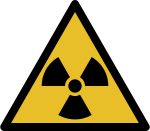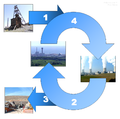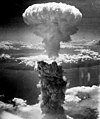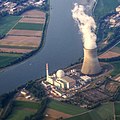Portal:Nuclear technology
The Nuclear Technology Portal
Introduction

- Nuclear technology is technology that involves the nuclear reactions of atomic nuclei. Among the notable nuclear technologies are nuclear reactors, nuclear medicine and nuclear weapons. It is also used, among other things, in smoke detectors and gun sights. (Full article...)
- Nuclear power is the use of nuclear reactions to produce electricity. Nuclear power can be obtained from nuclear fission, nuclear decay and nuclear fusion reactions. Presently, the vast majority of electricity from nuclear power is produced by nuclear fission of uranium and plutonium in nuclear power plants. Nuclear decay processes are used in niche applications such as radioisotope thermoelectric generators in some space probes such as Voyager 2. Reactors producing controlled fusion power have been operated since 1958, but have yet to generate net power and are not expected to be commercially available in the near future. (Full article...)
- A nuclear weapon is an explosive device that derives its destructive force from nuclear reactions, either fission (fission bomb) or a combination of fission and fusion reactions (thermonuclear bomb), producing a nuclear explosion. Both bomb types release large quantities of energy from relatively small amounts of matter. (Full article...)
General images -
Selected article -
Under an earlier agreement, the US had agreed to supply Skybolt missiles in return for allowing the establishment of a ballistic missile submarine base in the Holy Loch near Glasgow. The British Government had then cancelled the development of its medium-range ballistic missile, known as Blue Streak, leaving Skybolt as the basis of the UK's independent nuclear deterrent in the 1960s. Without Skybolt, the V-bombers of the Royal Air Force (RAF) were likely to have become obsolete through being unable to penetrate the improved air defences that the Soviet Union was expected to deploy by the 1970s.
At Nassau, Macmillan rejected Kennedy's other offers, and pressed him to supply the UK with Polaris missiles. These represented more advanced technology than Skybolt, and the US was not inclined to provide them except as part of a Multilateral Force within the North Atlantic Treaty Organization (NATO). Under the Nassau Agreement the US agreed to provide the UK with Polaris. The agreement stipulated that the UK's Polaris missiles would be assigned to NATO as part of a Multilateral Force, and could be used independently only when "supreme national interests" intervened.
The Nassau Agreement became the basis of the Polaris Sales Agreement, a treaty which was signed on 6 April 1963. Under this agreement, British nuclear warheads were fitted to Polaris missiles. As a result, responsibility for Britain's nuclear deterrent passed from the RAF to the Royal Navy. The President of France, Charles de Gaulle, cited Britain's dependence on the United States under the Nassau Agreement as one of the main reasons for his veto of Britain's application for admission to the European Economic Community (EEC) on 14 January 1963. (Full article...)
Selected picture -
Did you know?
- ... that the British Tychon missile was developed from a Barnes Wallis concept to keep strike aircraft safe while dropping nuclear bombs?
- ... that according to witnesses, the plutonium charge in the bomb used in the nuclear weapons test Gerboise Verte was transported in an economy car?
- ... that coral cores from Flinders Reef capture environmental changes caused by the use of nuclear weapons?
- ... that during World War II, pilot G. E. Clements was removed from training for secret missions associated with the Manhattan Project when senior officers realized she was a woman?
- ... that before becoming a successful children's author, Myron Levoy was an engineer doing research on nuclear-powered spaceships for a mission to Mars?
- ... that Project Ketch proposed the detonation of a 24-kiloton nuclear device in Pennsylvania to create a natural-gas storage reservoir?
Related WikiProjects
Things you can do
| Parts of this portal (those related to section) need to be updated. Please help update this portal to reflect recent events or newly available information. Relevant discussion may be found on the talk page. (September 2021) |
Selected biography -
Norman Foster Ramsey Jr. (August 27, 1915 – November 4, 2011) was an American physicist who was awarded the 1989 Nobel Prize in Physics for the invention of the separated oscillatory field method (see Ramsey interferometry), which had important applications in the construction of atomic clocks. A physics professor at Harvard University for most of his career, Ramsey also held several posts with such government and international agencies as NATO and the United States Atomic Energy Commission. Among his other accomplishments are helping to found the United States Department of Energy's Brookhaven National Laboratory and Fermilab. (Full article...)
Nuclear technology news
- 19 November 2024 – Russian invasion of Ukraine
- Nuclear risk during the Russian invasion of Ukraine, Russia and weapons of mass destruction
- Russian President Vladimir Putin signs a decree that allows Russia to use nuclear weapons in response to conventional attacks by a non-nuclear state supported by a nuclear power. (Reuters)
- 5 November 2024 – Fukushima nuclear accident
- A remote-controlled robot retrieves a piece of melted fuel from the Fukushima Daiichi Nuclear Power Plant, the first time a piece of melted fuel has been retrieved from a nuclear meltdown. (AP)
Related portals
Related topics
Subcategories
Associated Wikimedia
The following Wikimedia Foundation sister projects provide more on this subject:
-
Commons
Free media repository -
Wikibooks
Free textbooks and manuals -
Wikidata
Free knowledge base -
Wikinews
Free-content news -
Wikiquote
Collection of quotations -
Wikisource
Free-content library -
Wikiversity
Free learning tools -
Wiktionary
Dictionary and thesaurus






































































































